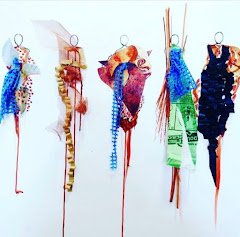Harlem Renaissance 1919 - 1930
The Harlem Renaissance began in 1919 and lasted until mid-1930’s. The roaring 20’s/Harlem Renaissance were in part a response to the immense loss of life that resulted from the Spanish Flu, also in 1918 - a pandemic that mirrors our experience of Covid in many ways. The black community, reeling from the horrors of slavery, but far enough away from themselves being slaves (and possibly the massive loss of life from the flu) were at a place to construct a new identity about what it meant to be a Black American. This is the foundation of the Harlem Renaissance - a search for a sense of their Identity within a space they never had the ability to shape on their own before. In the process of breaking down and rebuilding this national/cultural identity, Aaron Douglas - labeled the ‘father of Black American Art’ - was asked to do the important work of constructing a visual record of the shared history that united the black experience in America.

In Douglas’s most famous mural series depicting the history of the Black American, each piece has some specific components that help tell the narrative - a sense of moving along a pathway, away from darkness/subjugation towards a beacon of hope/light, a clear sense of the past, the current state of making headway towards a distant symbolic future, and a figure we are following, as they lead others along that same path. In Douglas' construction of Identity, all of his history, even the forgotten roots buried in countries far away, are rich resources that become key components of his narrative structure.
+ What is the nature of the path you are on in your life? Is it a stairway, a bridge, a yellow brick road? Is it well lit and welcoming, rough and overgrown in some parts, foggy sometimes and sunny others?
+ What are some symbols for the feeling of your past or the past? The light silliness of a curious childhood? Heavy with the weight of family struggle? Grey with the loneliness of the pandemic?
+What kind of futurescape do you envision for yourself? How does it feel? Is it light? Warm? Rich? Verdant?
+ Where are you on this path? What things do you carry: what lights your way? Are you on this path alone, or do you carry others with you? Are you our guide, or are you being guided?
AfroFuturism + Cyrus Kabiru
Born in 1984 in Eastlands Nairobi, he was one of six children living in a two-bedroom home opposite a refuse dump. Inspired by this view from his window, and a story his father told about how he accidentally broke his own glasses as a boy, he started making eyewear out of discarded cutlery and bottle tops. He was disinterested in school and got his friends to do his homework in exchange for specs. His father wanted him to study electronic engineering at university but he insisted on pursuing life as a self-taught artist instead.
“My work has everything to do with my dad. First the glasses. Now the bicycle. He raised me well and showed me the future. He wasn’t the kind of parent to give you things. Beyond food, clothes and
shelter, the next step was you.”
Part of a recent series, "Miyale Ya Blue" has one of the many transistor radios he has retrofitted. In an era when music and other media have migrated online, for Kabiru these objects not only elicit memories of gathering around his grandmother’s wireless to hear the news of the day but also are imbued with ancestral, spiritual powers that transport one imaginatively through space and time.
+ What are our resources? What is around us and inside of us, waiting patiently to be used, to inspire us, to redefine ourselves and what is possible?
Main Activity for the day:
Designing a group show that doesn't leave anyone's story behind
As a group, we will come up with the narrative for a collection that might travel a runway - then each person in the group will be responsible for some piece of the story - possibly one that reflects their own. Everyone gets to design, critique and eventually present their piece for our collection.
Anything is actually possible, so don't worry about going outside of the box:



















_2015_Pigment+Ink+on+HP+Premium+Satin+Photographic+Paper_150+x+120+cm.jpg)























No comments:
Post a Comment